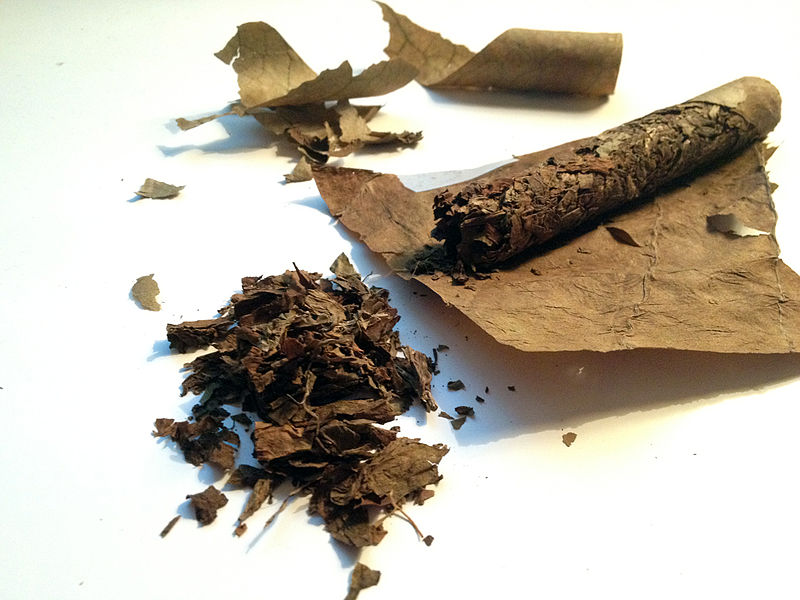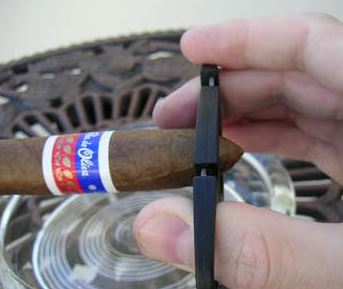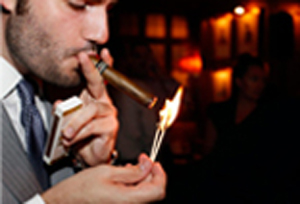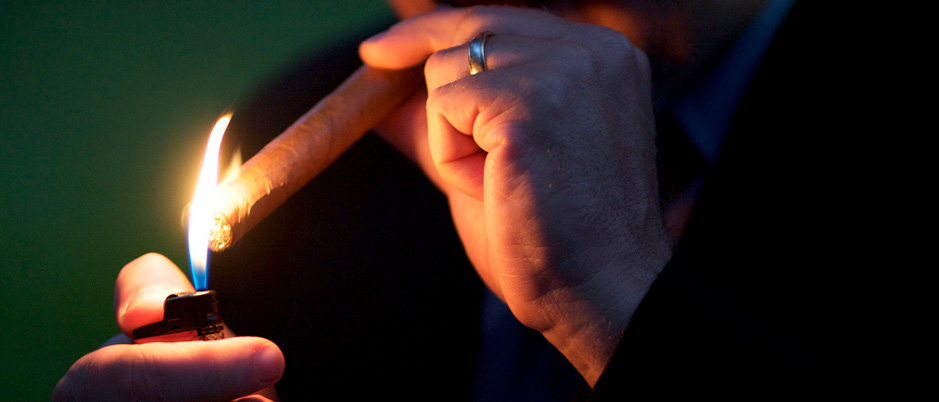Cigar 101
Introduction
 A cigar is a 100% natural product and consists of three tobacco
parts expertly rolled together: the wrapper, binder and filler.
A cigar is a 100% natural product and consists of three tobacco
parts expertly rolled together: the wrapper, binder and filler.
The wrapper is the outside leaf – it is what you see when
you look at a cigar. Its color and texture are the physical embodiment of the
cigar's character and it provides 30% to 60% of the cigar’s flavor and is by
far the most expensive component of the cigar.
Generally, darker cigar wrappers will tend to have a sweeter, fuller
flavor, while wrappers lighter in color tend to be milder. But again, this is a
general guide and flavor does vary according to the blend of the filler.
The binder holds the filler leaves in place and separates
them from the wrapper. If you were to remove the wrapper from a cigar, the next
leaf you would see would be the binder. It adheres to the wrapper; and also ensures
that the cigar burns well. Its purpose is mainly for construction and
consistency more than flavor.
The filler tobaccos are the innermost leaves of a cigar that
are held together by the binder. Filler tobacco is the "heart” of a cigar, and
consists of a carefully blended "recipe” of different tobaccos – often from
different countries - designed to complement the flavor of the wrapper.
The blender of the cigar carefully selects the above
components (wrapper, binder, filler,) for the overall smoking experience and the
flavor and body character of the cigar.
Measurements, Sizes
and Shapes
The length of a cigar is measured in inches or fractions of
an inch, but its diameter is measured in "ring gauges,” a unit of measurement
that is unique to the cigar industry. One ring equals 1/64th of an inch. That
means a cigar that is 5” x 32 would be five inches long and a half an inch in
diameter.
Here are some standard cigar sizes used by many
manufacturers, regardless of country of origin, however this is only a general
guide:
Double Corona
(7 ½” x 50+) also called a "Presidente” – Largest standard-sized cigars, these
are great after-dinner choices and will provide the fullest flavor and coolest
smoke. Double coronas take at least an hour to smoke.
Churchill (7” x 47) – The next largest size category, and a
term often used erroneously to describe any large cigar. And yes, it was
named after Winston Churchill, as this was his favorite shape.
Toro (6” x 50) it is also sometimes called a "Corona Gorda.”
The name literally means "fat corona." This is one of the most popular
sizes today, providing full flavor in a manageable amount of time.
Lonsdale (6 1/2” x 42) – This has always been one of the
most popular sizes in the United
States. However, recently the Lonsdale
has been losing popularity to larger-ringed cigars.
Corona
(5 1/2” x 42) – Same ring size as a Lonsdale, just an inch shorter. It
used to be the second most popular size in the United States, although, like the
Lonsdale, it has been losing ground to larger diameter cigars.
Robusto (5” x 50) – A great trade-off between time and
taste; a robusto provides big cigar flavor and coolness in a shorter cigar that
only takes about 30 to 45 minutes to smoke. This shape is traditionally
known as a Rothschild, and is one of the most popular sizes today.
Panatela (6” x 38) it is sometimes called a "Lancero” – A
popular shape in the 50’s and 60’s and still favored in Europe.
Women often feel more comfortable with this sleek and elegant size. Many
cigar aficionados also prefer this size because the small ring guage and long
size allows for the wrapper’s taste to dominate.
Figurado Cigars – The word "Figurado” means "figured” or
"shaped.” These are cigars that do not have traditional straight
cylindrical sides with a cut foot and a rounded head.
There are three types of Figurados:
Perfecto – A cylindrical cigar with
a pointed or "perfecto” head and foot. Traditionally, these have been
cigars that are pointed or tapered at both ends, with a "fat” or swollen
mid-section.
Pyramid – A cigar that is pointed
at the head and with slightly slanted sides, like an elongated pyramid.
Belicoso or Torpedo – A cigar with
a pointed head or cap and parallel sides.
The shape designation of a cigar does not mean a cigar is a certain size.
The reason for that is when determined by a name such as corona or robusto, it
is not a true universal standard. For example, a corona sized cigar from one
manufacturer can easily be considered a Churchill by a different manufacturer,
even though both cigars measure the exact same length and ring gauge. However, there are some classic measurements
for cigars that most cigar makers attempt to follow. When it comes to cigar
sizes, the most important thing to remember is that cigars are categorized by
length and ring gauge.
The Smoking Process
Cigar smoking involves cutting, toasting, lighting, tasting
and grading its character, as well as the proper storage of your collection.
Below are some instructions that will help you look like a true cigar
aficionado.

First, using your cigar cutter of choice (although we prefer the guillotine),
make a deft cut or opening at the head of the cigar – the closed end, aka the
part you will be putting between your lips.
Do this above or at the seam that you will see at the shoulder, or
sloped part of the head. When cutting a cigar, if you cut too far down
into the cigar, below the seam, the entire cigar could unravel so be careful
where you make your cut. If you cut too
far into the cap of the cigar, that will cause the wrapper, the outermost leaf,
to unravel. Go ahead and leave the band on. Trying to take
it off prematurely risks tearing the wrapper.
It is a reference point in handing a cigar and knowing when a cigar
should be extinguished, normally at 1.5” to 2.”
 Next, whether using a wooden (not cardboard) match, butane
lighter, or cedar splint, the lighting ritual is the same. Don’t use cardboard
matches because they’re tainted with chemicals and can ruin the cigar. Instead,
use a torch or butane lighter (not a lighter whose fluid can impart a flavor on
the cigar, i.e. Zippo). The lighting
process starts with toasting the foot of the cigar to prepare it for lighting.
With the cigar at a 45 degree angle, hold the tip of the flame directly
underneath the foot or tuck end of the cigar. Never let the flame touch the
tobacco and risk charring that beautiful wrapper. The tip is the hottest part
of the flame, and you want to toast the open end of the filler leaves to dry
them out. This will prepare the tobacco to more readily accept the flame when
you actually light the cigar. Gently
rotate the cigar as you toast it. Be sure to get the entire circumference
smoldering. When a whiff of smoke starts
to curl up, place the cigar in your mouth, and puff gently while continuing to
rotate the cigar over the tip of the flame without letting the flame touch the
cigar. As you puff, you will eventually see the flame flare up and ignite the
cigar’s foot. Continue to rotate the cigar, until the entire foot is glowing.
Now you are ready to relax with your cigar.
Next, whether using a wooden (not cardboard) match, butane
lighter, or cedar splint, the lighting ritual is the same. Don’t use cardboard
matches because they’re tainted with chemicals and can ruin the cigar. Instead,
use a torch or butane lighter (not a lighter whose fluid can impart a flavor on
the cigar, i.e. Zippo). The lighting
process starts with toasting the foot of the cigar to prepare it for lighting.
With the cigar at a 45 degree angle, hold the tip of the flame directly
underneath the foot or tuck end of the cigar. Never let the flame touch the
tobacco and risk charring that beautiful wrapper. The tip is the hottest part
of the flame, and you want to toast the open end of the filler leaves to dry
them out. This will prepare the tobacco to more readily accept the flame when
you actually light the cigar. Gently
rotate the cigar as you toast it. Be sure to get the entire circumference
smoldering. When a whiff of smoke starts
to curl up, place the cigar in your mouth, and puff gently while continuing to
rotate the cigar over the tip of the flame without letting the flame touch the
cigar. As you puff, you will eventually see the flame flare up and ignite the
cigar’s foot. Continue to rotate the cigar, until the entire foot is glowing.
Now you are ready to relax with your cigar.
 Remember as you smoke, a cigar is never inhaled. The smoke
is sipped, like a fine liquor, then gently blown out (exhaled), leaving all the
flavor on your palate. Sample the body
and the flavor of the cigar. Many
smokers, new and experienced alike, often confuse concepts of body and flavor. Body refers to the strength or intensity, usually
described as full, medium, or mild. The
ring gauge of the cigar will give you a general indication of how full the body
is. The larger the ring size, generally, the fuller, smoother, cooler, and
slower the smoke will be. Flavor refers
to the actual taste of the cigar and includes tasting notes such as those used
for fine wine and spirits, tea, and coffee.
To evaluate the cigar flavor, hold the smoke in your mouth for a few
seconds and allow your tongue and upper palate to savor the different taste
sensations. A cigar's flavors can range from spicy, sweet, peppery, salty,
harsh, nutmeg, earthy, woody, cocoa, roasted, nutty, cedar, oak, fruity,
leathery and many more.
Remember as you smoke, a cigar is never inhaled. The smoke
is sipped, like a fine liquor, then gently blown out (exhaled), leaving all the
flavor on your palate. Sample the body
and the flavor of the cigar. Many
smokers, new and experienced alike, often confuse concepts of body and flavor. Body refers to the strength or intensity, usually
described as full, medium, or mild. The
ring gauge of the cigar will give you a general indication of how full the body
is. The larger the ring size, generally, the fuller, smoother, cooler, and
slower the smoke will be. Flavor refers
to the actual taste of the cigar and includes tasting notes such as those used
for fine wine and spirits, tea, and coffee.
To evaluate the cigar flavor, hold the smoke in your mouth for a few
seconds and allow your tongue and upper palate to savor the different taste
sensations. A cigar's flavors can range from spicy, sweet, peppery, salty,
harsh, nutmeg, earthy, woody, cocoa, roasted, nutty, cedar, oak, fruity,
leathery and many more.
Occasionally blow the smoke over the ash of the cigar and
inspect the ash. That shows you know to
look for an even burn. A solid ash is a
hallmark of a high quality, well constructed cigar. Never snuff out a fine
cigar like a cigarette. Simply place the butt in an ashtray and let it go out
of its own accord. Again, cigars are not made with chemicals that cause them to
burn, so simply letting the cigar extinguish itself is the best way to end a
great cigar smoking experience.
Caring for your Cigars
A humidor is a specially designed box for holding cigars.
It's most often made of Spanish cedar and contains a hygrometer to maintain a
constant humidity. A constant and proper humidity is essential to keep cigars
from drying out or from being too moist and developing mold. A consistent
temperature of 68°-70° F and a relative humidity of 70-72% keep your smokes in
perfect shape. Proper storage at the appropriate humidity and temperature is
the most critical factor in aging and maintaining quality cigars. However, there are some steps required to
season your humidor before you can safely add cigars. The wood interior of the humidor needs to
absorb humidity before it can become the ideal home for your cigars. Here's
what to do:
1. With a new sponge, or lint-free cloth—unscented,
free of soap and liberally dosed with distilled water (this is important) —wipe
down all exposed wood, including any trays and dividers, as well as the interior
lid. Avoid using a paper towel or a fraying cloth; these will literally leave a
paper trail or lint on the wood. After you've wet the wood, squirt the sponge or
lint-free cloth with some more distilled water, then place it inside the
humidor on a plastic bag (to avoid contact with the wood) and close the lid.
2. Next, prepare your humidification device
according to the manufacturer's instructions. Use only distilled water, or
specialized propylene glycol solution for humidors. Tap water contains minerals
that will destroy most humidification systems by leaving deposits that will
clog the humidor element. Once the humidification element is filled, be sure to
wipe it down to remove all the excess water. Rest it on a hand towel for
approximately 30 minutes to allow any excess water or solution to drip
off. Add the humidifying element to the
humidor and close the lid, leaving the damp sponge that has been placed on the
plastic bag inside, and leave it overnight.
3. The next day, refresh the humidification
device if it needs more water, and check the sponge. If it is fairly dry, add
more distilled water. If it is very damp, leave it alone. Let the humidor sit
another night, then remove the sponge and plastic bag. The walls of the humidor
have now absorbed all the water they need, and you can safely add cigars.
4. To calibrate your hygrometer,
dampen a towel (not dripping wet, but very damp), then wrap the hygrometer in
the towel for 30 to 45 minutes. Then quickly unwrap it and read the
humidity. If your hygrometer is perfectly calibrated (few are because
climates vary according to barometric pressure and relative ambient humidity)
it will be reading exactly 100% humidity. Most likely, it will be reading
somewhere between 80% and 90%. If it's
reading 90%, then you know that when it's in your humidor and reading 65%, your
humidor is really at 75%. Or you can turn over your hygrometer and adjust
the calibration screw accordingly until it is perfectly calibrated.